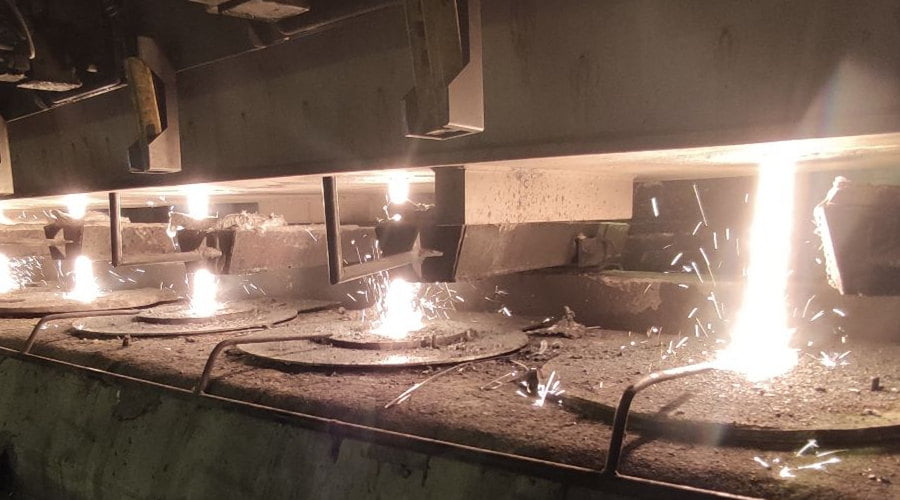Do you want to know the principle of induction furnace+vertical continuous casting machine? Do you know the advantages and disadvantages of an induction furnace+vertical continuous casting machine?
1. Principle of Induction Furnace+Vertical Continuous Casting Machine
(1) Heating Principle of Induction Furnace
The induction furnace mainly consists of a power supply, an induction coil, and a crucible made of refractory materials inside the induction coil. The crucible contains metal furnace material, which is equivalent to the secondary winding of a transformer. When the induction coil is connected to an AC power supply, an alternating magnetic field is generated inside the induction coil.
The magnetic field lines cut the metal furnace material in the crucible, creating an induced electromotive force in the furnace material. Since the closed circuit is formed by the furnace material itself, this secondary winding has only one turn and is closed. So, an induced current is generated simultaneously in the furnace material, and when the induced current passes through the furnace material, it heats it to promote its melting.
The induction melting furnace uses an intermediate-frequency power supply to establish an intermediate-frequency magnetic field. It causes induced eddy currents and heating inside the ferromagnetic material, achieving the purpose of heating the material. The intermediate frequency furnace adopts a 200-2500Hz intermediate frequency power supply for induction heating, melting, and insulation.
The intermediate frequency furnace is mainly used for melting carbon steel, alloy steel, and special steel. And can also be used for melting and heating non-ferrous metals such as copper and aluminum. The equipment has a small size, lightweight, high efficiency, low power consumption, fast melting and heating, easy furnace temperature control, and high production efficiency.
(2)Working Principle of Vertical Continuous Casting Machine
A vertical continuous casting machine refers to a type of continuous steel casting machine in which the entire process of casting and billet solidification is carried out in a vertical state. Vertical continuous casting machine has the characteristics of uniform cooling of the billet and good symmetry of solidification structure.
A series of equipment and operations such as the tundish, crystallizer, secondary cooling support device, tension straightening machine, billet cutting equipment, etc. of the vertical continuous casting machine is arranged on a vertical centerline. When the molten steel is injected into the crystallizer from the tundish, the initial set billet accelerates solidification through the secondary cooling zone and is pulled out at the set pulling speed of the billet drawing machine. After cutting, the fixed-length billet enters the tilting bucket.
When receiving the casting billet, the tilting bucket will place it in a horizontal state and transport it out by a conveyor roller (the pit-type casting machine has an elevator to lift the billet to the ground level and then output it by the ground roller). Or the tilting steel bucket will tilt it onto an inclined track conveyor, which will transport the billet to the ground and output it by the ground roller, and then the steel pulling (or pushing) machine will push the billet onto the centralized cooling bed.
Characteristics of Induction Furnace+Vertical Continuous Casting Machine
Advantages and Disadvantages of Induction Furnace
The furnace material in the induction furnace generates heat by itself, thus it has higher efficiency than other indirect heating methods, low power consumption, small metal burning loss, and low pollution to the power grid and air. Therefore, it is still the most effective and environmentally friendly equipment for melting various metals so far.
In order to further save energy and protect the environment, induction furnace manufacturers have developed the most advanced solid-state intermediate frequency furnace (series inverter circuit, frequency modulation and power regulation). And that saves 10% of electricity and reduces interference to the power grid by half.
Things always have their advantages and disadvantages. Due to induction heating, the induction furnace has induction electricity in both the furnace material and shell. Especially for large-tonnage furnaces and energy-saving and environmentally friendly solid-state intermediate frequency furnaces, their induction power is higher. In addition, the lining thickness of the intermediate frequency furnace is relatively thin.
Therefore, special attention should be paid to safety during use. The induction furnace and gas combustion furnace are widely used and widely used in our Xinghua area, providing a lot of help for the development of the local economy. But we need to pay special attention to the safe use of intermediate frequency furnaces and gas combustion furnaces.
Main Process Characteristics of Vertical Continuous Casting Machine
1. The steel liquid is injected into an upright crystallizer from the tundish, and large particle inclusions and some small inclusions in the steel liquid may float to the surface. When using protective slag for pouring, the inclusions can be absorbed by the protective slag, and the residual inclusions in the billet are evenly distributed. It can avoid the accumulation of inclusions on the inner arc surface during arc continuous casting.
2. The cooling of the billet is uniform, and the symmetry of the solidification structure is good.
3. During the solidification process and in the casting machine, the billet is not subjected to external forces such as bending and straightening. There are no cracks or defects caused by mechanical stress inside the billet. due to the high static pressure of the steel, it is easy to solidify and supplement. Therefore, vertical continuous casting is suitable for pouring alloy steel and steel grades with high crack sensitivity.
Are you looking for an induction furnace+vertical continuous casting machine? We are ready to supply the best solution for you. We are looking forward to our cooperation.

